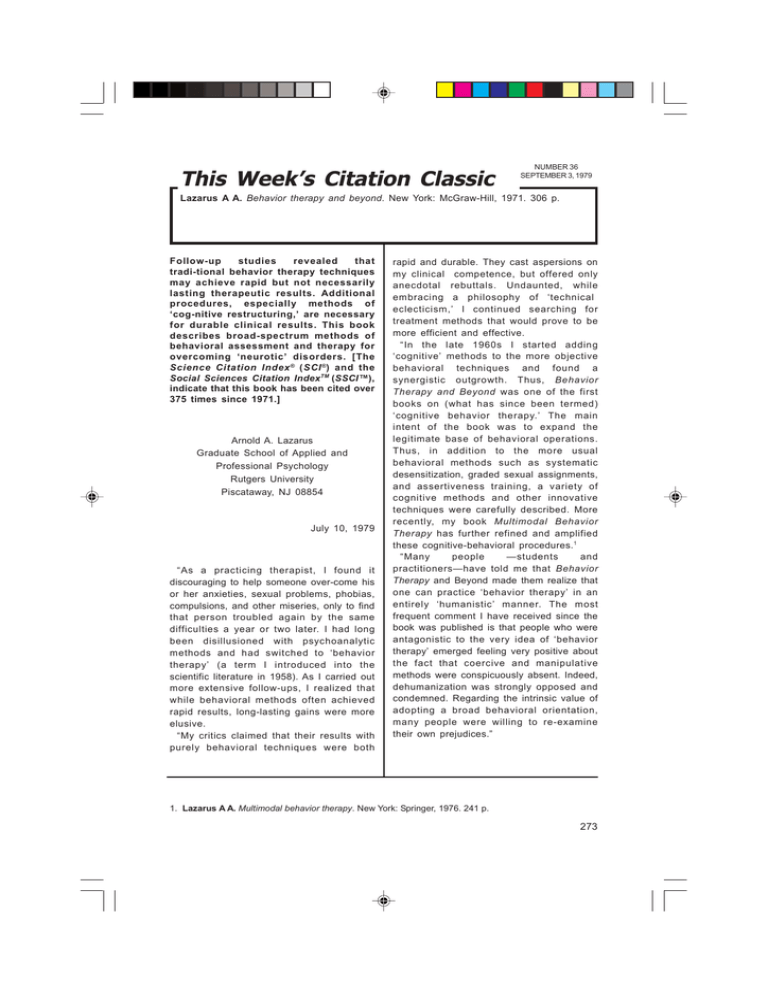Lazarus A A. Behavior therapy and beyond. New York: McGraw
advertisement

This Week’s Citation Classic NUMBER 36 SEPTEMBER 3, 1979 Lazarus A A. Behavior therapy and beyond. New York: McGraw-Hill, 1971. 306 p. Follow-up studies revealed that tradi-tional behavior therapy techniques may achieve rapid but not necessarily lasting therapeutic results. Additional procedures, especially methods of ‘cog-nitive restructuring,’ are necessary for durable clinical results. This book describes broad-spectrum methods of behavioral assessment and therapy for overcoming ‘neurotic’ disorders. [The Science Citation Index ® (SCI ® ) and the Social Sciences Citation Index TM (SSCI™), indicate that this book has been cited over 375 times since 1971.] Arnold A. Lazarus Graduate School of Applied and Professional Psychology Rutgers University Piscataway, NJ 08854 July 10, 1979 “As a practicing therapist, I found it discouraging to help someone over-come his or her anxieties, sexual problems, phobias, compulsions, and other miseries, only to find that person troubled again by the same difficulties a year or two later. I had long been disillusioned with psychoanalytic methods and had switched to ‘behavior therapy’ (a term I introduced into the scientific literature in 1958). As I carried out more extensive follow-ups, I realized that while behavioral methods often achieved rapid results, long-lasting gains were more elusive. “My critics claimed that their results with purely behavioral techniques were both rapid and durable. They cast aspersions on my clinical competence, but offered only anecdotal rebuttals. Undaunted, while embracing a philosophy of ‘technical eclecticism,’ I continued searching for treatment methods that would prove to be more efficient and effective. “In the late 1960s I started adding ‘cognitive’ methods to the more objective behavioral techniques and found a synergistic outgrowth. Thus, Behavior Therapy and Beyond was one of the first books on (what has since been termed) ‘cognitive behavior therapy.’ The main intent of the book was to expand the legitimate base of behavioral operations. Thus, in addition to the more usual behavioral methods such as systematic desensitization, graded sexual assignments, and assertiveness training, a variety of cognitive methods and other innovative techniques were carefully described. More recently, my book Multimodal Behavior Therapy has further refined and amplified these cognitive-behavioral procedures. 1 “Many people —students and practitioners—have told me that Behavior Therapy and Beyond made them realize that one can practice ‘behavior therapy’ in an entirely ‘humanistic’ manner. The most frequent comment I have received since the book was published is that people who were antagonistic to the very idea of ‘behavior therapy’ emerged feeling very positive about the fact that coercive and manipulative methods were conspicuously absent. Indeed, dehumanization was strongly opposed and condemned. Regarding the intrinsic value of adopting a broad behavioral orientation, many people were willing to re-examine their own prejudices.” 1. Lazarus A A. Multimodal behavior therapy. New York: Springer, 1976. 241 p. 273


